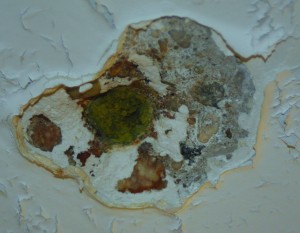By Aja Neal (Special to The Chronicle) Stacey Robinson, senior community health major, and Toni Simone, junior anthropology and secondary education major, had just moved into their Vander Poel dorms this year. Upon entering their bathroom, they discovered yellow, bubble-shaped droplets growing on the ceiling. These were mold droplets.
The girls reported the issue right away to Residential Assistants in to their building. They suggested to file a work request to Public Safety through the University’s website.
“I later heard from two RAs that mold constitutes an emergency situation, and that I should call Public Safety personally,” Simone said.
Simone called the day after and the situation within a few hours. Or so they thought.
By next week, the mold returned because the bathroom vent was not circulating properly, so Simone sent in another work order to have the issue fixed the following day. This time, the work was successful.
“The mold was completely removed and the air in the bathroom seemed less stuffy because they investigated the situation and repaired the vent, too,” Simone said.
This situation is not new.
An increasing number of on-campus residents are dealing with mold issues this semester. Mold has been appearing in dorms, bathrooms and ventilation systems in the residence halls.
Rachel Peace, senior public relations major, moved into Enterprise Hall this year and was well aware of the mold situation on campus. When she inspected her dorm, she found a fine specimen of mold lurking in her HVAC unit.
“I called the emergency number on my RA’s door, but no one called back,” Peace said. “It turns out that people did come by the room to check for mold, but they didn’t look in the air conditioning unit.”
Peace asked a custodian in her residence hall if he could take a look at the HVAC mold and he contacted his boss right away to rectify the issue.
“He came himself to bleach the grills of the AC, and then I showed him how it went down into the vents inside. He said that we needed the air conditioning man to fix that part, but he then contacted that person and helped me move my furniture out of the way so the guy who was coming in could access it,” said Peace.
While the helpful custodian assisted her, he also informed her that someone had come by the room previously but had not been aware of the location of the mold when they arrived.
Though Peace believes that the maintenance worker’s actions were extremely helpful, she was not pleased with the way that her situation was handled because she could not risk using the air conditioning and circulating spores around the room when it was hot.
Residential Programs has guidelines for students to take the necessary precautions to address and handle mold issues in residence halls.
According to Jean Anne Smith, Associate Director of Residential Programming, the discovery of mold in any dorm is considered an emergency. The student or RA can call either the Facilities and Operations department or Public Safety for assistance.
Dom Lavin, Director of Campus Operations at Hofstra University, explained that mold forms because of the leftover humidity that lingers in the air from the warmer temperatures.
“In general, what will happen is if someone turns the air conditioner on to the lowest possible setting or the highest fan, the room gets very cool. Then they decide to turn off the air and open windows. The humid air comes in and condenses on the cold surfaces of the room. You have the ingredients right there, you get the moisture and the mold,” Lavin said.
Lavin provided advice to prevent mold growth. He encouraged students to practice good hygiene. This means to keep a clean bathroom, keep the vents open and clear of any personal objects, and to avoid opening windows in a too cold room after turning the AC off.
“The best way to keep the moisture in your room down is to keep your air conditioner on either a low fan setting, just a moderate 72 degree setting. Not all ACs are digital though, so just use a mid range setting,” Lavin said. “The AC then works slowly and as it works, it brings that excess moisture out of the air and keeps the room at a comfortable temperature.”
Though the mold situation is not under control, it is being looked into.
“We track mold, and we take it very seriously because some people can be allergic to certain strains. Our custodians will respond to the mold call immediately, whether the student is in their room or not,” Lavin said. “We’ll send somebody in afterwards to make sure that there’s not some sort of recurrent issue.”



